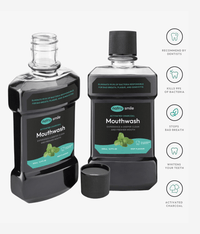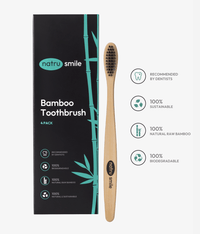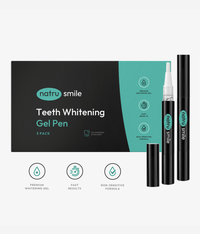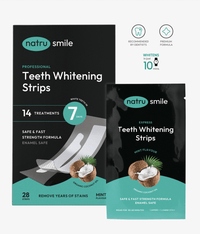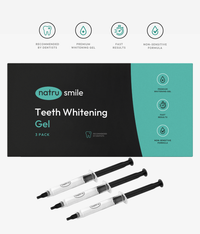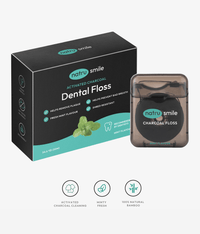
All products are certified by dental expert Dr. Greg Grillo
No matter how you look at it, braces are a nuisance. The metal or ceramic brackets and wires get in the way of your smile, irritate your mouth, and they are difficult to clean.
But for millions of people, their ability to straighten teeth and fix cosmetic issues for the long term makes them a necessary evil.
In the past, if you wanted to improve your smile, you needed to wear traditional braces, which required wires and metal brackets to be glued to your teeth. Now, options like Invisalign and clear braces offer subtle, convenient solutions to correct misaligned teeth.
But which is the best?
In this article, we'll compare clear braces and Invisalign to help you make the best decision for your mouth.
What Are Clear Braces?
In the past, getting braces involved choosing a brace color and wearing a mouthful of metal and wires for up to two years.
Today, clear braces are an alternative that uses tooth-colored ceramic brackets instead of metal ones. They blend in with natural teeth, making them less noticeable than traditional braces.
The brackets are connected with a wire that needs to be tightened periodically by your orthodontist. They work in the same way as traditional braces, but are less noticeable due to their subtle color.
What Is Invisalign?
Invisalign is a treatment that uses clear mouth trays known as aligners instead of brackets and wires to straighten teeth. The aligners are custom-made for your teeth and must be worn for 20 to 22 hours daily.
Clear Invisalign aligners are transparent and fit snugly over your teeth, making them almost undetectable to the naked eye (from far away). They need to be replaced every one to two weeks as your teeth gradually move into alignment.
Clear Braces Vs. Invisalign: Comparison
To understand whether clear braces or Invisalign is the right choice for you, you need to compare the two options based on some important criteria. Primary factors include the following:
Cost
For many, cost is the most important factor to consider. Since both braces and Invisalign trays are long-term treatments that require several dental check-ups, even small differences in individual costs can add up over time.
Typically, ceramic (i.e., clear) braces cost are about the same as Invisalign trays. On average, invisible braces cost between $3,000 and $7,000. For some patients, however, the cost can be as low as $1,800.
Comparatively, Invisalign trays cost between $3,000 and $5,000, a price that has come down significantly with the accessibility of 3D printing technology. Invisalign can also be the more expensive option for complex cases, as it requires multiple sets of aligners and check-ups to ensure proper alignment.
There are a few factors that influence this:
- The severity of tooth misalignment
- General oral health quality
- The length of treatment required (e.g., bite correction vs. simple teeth alignment)
- The cost of living in your area
- Doctor experience (e.g., orthodontist vs. general dentist)
When comparing the costs, the cheaper option will come down to the individual situation.
Invisalign trays may be slightly more expensive, especially if you can get a good deal on braces. But they average out to about the same costs, so it's best to compare the two based on what your treatment provider can offer you.
Risks
Risks are a primary concern for most patients. With clear braces, the ceramic brackets can be more prone to breaking and can also cause irritation if not fitted properly.
Invisalign risks are less severe, as the trays are generally easier to put in and take out without any risk of damage or discomfort. However, Invisalign does require a lot of motivation from the patient to wear them for the required amount of time, as not doing so can result in slower treatment progress and more frequent check-ups (or treatment that doesn't work altogether).
Appearance
Of course, nobody wants to wear braces of any kind if they don't have to. Unfortunately, every method of straightening teeth requires some form of appliance to be worn.
If you're open to displaying your orthodontic appliance, clear braces are an outstanding solution - their tooth-colored brackets blend in naturally with the rest of your teeth and are far less visible than traditional metal ones.
However, they do have a few issues:
- If food gets stuck between invisible braces, it might show more than with traditional braces.
- Tooth discoloration might be more noticeable against an enamel-colored bracket, increasing the need to get rid of yellow teeth while wearing one.
- The brackets may be less noticeable, but they can still be visible from certain angles or in certain lighting.
Although Invisalign touts its status as an inconspicuous way to straighten teeth without braces, it comes with a few drawbacks, including:
- Plastic trays can be less effective for serious orthodontic cases.
- Trays can become loose or even fall out if not worn properly, leading to an improper fit and slower treatment progress.
- The plastic film can create a temporary lisp or whistling sound when speaking.
- Plastic covering your teeth can look shiny and unnatural.
Invisalign trays are generally more discreet than clear braces, but some users don't particularly like the way they reflect on their teeth.
Restrictions
While you have braces, teeth whitening and other cosmetic dental procedures are strictly off-limits. Since brackets cover the majority of your visible smile, you will need to wait until the braces are removed before you can make any aesthetic changes.
Invisalign users, however, don't have this restriction since their trays are removable. This gives them more teeth whitening options and allows them to perform other cosmetic dental procedures while in the middle of treatment.
Comfort
Braces are notoriously uncomfortable, which is one of Invisalign's biggest advantages.
Since they don't require any kind of wire, Invisalign trays fit more snugly and are much less likely to cause cuts, abrasions, or sores in the mouth or gums. They will take some getting used to, but Invisalign trays tend to cause less irritation than traditional braces.
In contrast, clear braces do have some potential comfort issues due to the brackets and wires that must be tightened regularly by an orthodontist. Although ceramic brackets are much less noticeable to the naked eye than metal ones, they will still cause significant discomfort (and potential oral abrasions), especially when newly fitted.
Brushing And Flossing Options
Oral hygiene is critical, especially when you're straightening or realigning your teeth. And when it comes to brushing and flossing, Invisalign offers unique advantages.
Brushing your teeth with braces is a complete hassle—you have to be extra careful around brackets and wires, and it often takes longer than usual. Even after brushing, taking extra care to floss with special threaders, and using small brushes and special water flossers, the food particles left inside your mouth might still cause cavities and other oral health issues.
With Invisalign, however, you can simply take out the trays for brushing and flossing as usual. This makes it much easier to keep up with your oral hygiene routine without having to worry about anything getting stuck in your braces.
Treatment Length
Patients want to get their teeth straightened as soon as possible. In addition to being inconvenient, braces can also be quite embarrassing, especially for adults.
On a case-by-case basis, Invisalign has been shown to work faster. However, the length of treatment depends on several factors, such as the severity of misalignment and the patient's adherence to wearing their aligners.
For more severe cases, clear braces may be the better option since they come with metal wires that can exert more pressure and create longer-lasting results than Invisalign trays.
Requirements
Both Invisalign and clear braces have their own set of requirements, and it's up to the user to decide which is more inconvenient.
Invisalign holds users responsible for wearing their trays at least 20 hours per day. Invisalign users also need to plan ahead so they have enough trays for future use. Especially if they are planning to travel or go on vacation, poor planning could result in days or weeks without treatment.
Clear braces don't require any of that, but they do require their own set of responsibilities. Cleaning teeth with braces requires extra caution and attention when brushing and flossing. Users must also be very careful with what kind of food they eat, as certain items can become stuck in the brackets or wires.
There is an accountability aspect to both teeth straightening methods. The one that works best for you will depend on which type of responsibility you're able to handle best.
Gum Irritation
Gum irritation is an unpleasant but unavoidable part of wearing braces. Clear braces function similar to traditional ones, meaning the brackets and wires can cause some mild to significant gum irritation.
Invisalign trays, on the other hand, are made out of plastic and don't require any tightening or placement of metal components into the gums, which means fewer instances of gum pain and discomfort.
If you have sensitive gums, Invisalign may be the better option.
The Bottom Line
Invisalign and clear braces both offer a great way to get straight, healthy teeth. The decision of which one is right for you will depend on your unique needs and preferences. Since braces cost about the same as Invisalign in many cases, consider the length of treatment, brushing and flossing options, requirements, and gum irritation when making your final decision.
If you value convenience, shorter treatment times, and reduced gum irritation, Invisalign is the best choice for you. But if you prefer a lower maintenance approach and reliable results, clear braces may be the better option.
Want to learn more? Here are the questions our customers ask us the most.
What Are Better: Clear Braces Or Invisalign?
Whether you choose clear braces or Invisalign depends on your needs and preferences. Invisalign is more convenient and often requires less treatment time, but clear braces provide a more reliable result for more severe cases of misalignment.
Do Clear Braces Work Faster Than Invisalign?
Clear braces (and other types of traditional braces) apply constant pressure through metal wires, while Invisalign trays are replaced every two weeks. However, Invisalign has been shown to work faster than traditional braces. This makes Invisalign a better choice for mild to moderate misalignment cases.
Do Dentists Prefer Invisalign Or Braces?
The Invisalign system makes it easier for dentists to monitor progress. For patients, it features greater comfort and convenience since it doesn't require metal wires or brackets. Its ability to speed up the treatment process also makes Invisalign a preferred choice for many dentists.
Do Teeth Move Faster With Braces Or Invisalign?
In general, Invisalign works faster than traditional braces. This is because Invisalign trays are replaced every two weeks, allowing for constant and consistent pressure to be applied to the teeth. However, some patients find that traditional braces work faster for correcting more severe cases of misalignment.
Can I Switch From Invisalign To Braces?
Occasionally, patients find that they don't like the frequent application and removal of Invisalign trays. Some dentistries allow patients to switch from Invisalign to braces at no additional cost. This makes it easier for patients to give Invisalign a try first and then switch to braces if they don't like the Invisalign system.
Can You Whiten Your Teeth While Wearing Invisalign Aligners?
One of the best things about Invisalign is that you can go through teeth whitening sessions while wearing the aligners. This makes it much easier to get the perfect smile without having to wait until after treatment is complete.
The same cannot be said for traditional braces, as whitening can cause uneven coloration throughout the teeth.
Should You Whiten Your Teeth Before Or After Invisalign?
You can whiten your teeth before or after using Invisalign. You can also whiten your teeth while wearing the aligners. The best option for you will depend on your goals and how much discoloration you want to correct. It will also depend on your budget, which may be a deciding factor in when to whiten your teeth.
Clear Braces Vs. Invisalign: Which Is Faster?
Invisalign has been shown to work faster than traditional braces in many cases. This is because Invisalign trays are replaced every two weeks, allowing for constant and consistent pressure to be applied to the teeth. However, some patients may find that traditional braces work more effectively for correcting more severe cases of misalignment.
Which One Is Better: Clear Or Metal Braces?
Clear and metal braces cost about the same and share the same functionality. So when comparing the two, it comes down to personal preference. Clear braces are less visible, but they aren't invisible—it is still clear when a person is wearing braces. Metal braces are more visible, but they can also come in a variety of colors and designs if you want to make a fashion statement out of it.
Are Clear Braces A Good Idea?
Clear braces are popular among those who want to correct their misalignment without having to wear traditional metal braces. Clear braces are less visible than metal braces, and they offer the same functionality as metal braces. They do have a few drawbacks, though. When compared to Invisalign, clear braces are more time-consuming and require more maintenance. And when compared toother types of braces, they might highlight discoloration over time by gradually becoming discolored themselves.
Are Clear Braces More Expensive?
Clear braces are generally about the same cost as colored braces. And when compared to Invisalign, the price is also comparable. The overall cost of any braces treatment depends on how long it will take, the condition's severity, and whether there are any other treatments or procedures that need to be done in order to resolve the condition.
Do Clear Braces Turn Yellow?
Ceramic is highly resistant to stains, so clear braces generally don't turn yellow. However, they can become discolored over time due to their exposure to the elements and your daily activities. And if you don't maintain good oral hygiene, the tooth underneath may become discolored—a condition which can show through your braces and appear yellow.
What Foods Should You Avoid With Clear Braces?
If you have clear braces (or any braces, really) you should avoid sticky, chewy, and hard foods that can damage the brackets or wires. These include gum, popcorn kernels, nuts, hard candy, and ice cubes. You should also avoid sugary snacks as they can cause tooth decay and discoloration. Additionally, any food that requires you to chew with your front teeth—such as corn on the cob—should be avoided when possible
Do Clear Braces Get Dirty?
Like any oral appliance, clear braces can get dirty over time. It's important to brush your teeth and floss regularly with braces to avoid plaque buildup that can cause discoloration. Cleaning the brackets and wires of your clear braces at least twice a day is also recommended. You should also have regular checkups with your orthodontist to ensure that your braces are clean and that your treatment is progressing as expected.
Do Clear Braces Hurt?
Many people claim their teeth hurt with braces, and this is common with both clear and metal braces. The level of discomfort varies from person to person, but it usually goes away after a few days as the mouth adjusts to the braces. Orthodontists can also use wax or provide other pain relief techniques to help minimize any discomfort associated with your braces.
Can Everyone Get Clear Braces?
Clear braces are available at just about every dentist's office, but not everyone is a candidate for clear braces. Your orthodontist will need to evaluate your mouth and decide if they're the right option for you. Even if clear braces are an option, they may not be the best choice in terms of efficacy or cost. Invisalign is often recommended as a more effective alternative treatment for its faster results and easier maintenance.
Do Clear Braces Straighten Teeth?
Clear braces can effectively straighten teeth and correct misalignment, just like traditional metal braces. The main difference is that clear braces are less visible than regular metal braces. They also offer the same functionality as metal braces but may require more maintenance due to their less secure fit.


